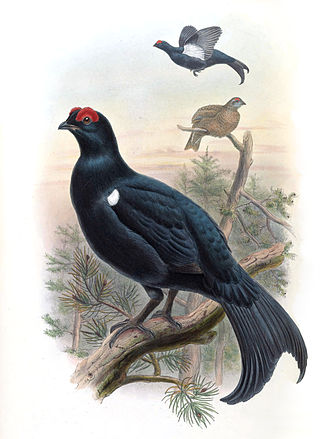
The sand partridge is a gamebird in the pheasant family Phasianidae of the order Galliformes, gallinaceous birds.

The Caucasian grouse or Caucasian black grouse is a large bird in the grouse family. It is closely related to the black grouse.

Grosbeak is a form taxon containing various species of seed-eating passerine birds with large beaks. Although they all belong to the superfamily Passeroidea, these birds are not part of a natural group but rather a polyphyletic assemblage of distantly related songbirds. Some are cardueline finches in the family Fringillidae, while others are cardinals in the family Cardinalidae; one is a member of the weaver family Ploceidae. The word "grosbeak", first applied in the late 1670s, is a partial translation of the French grosbec, where gros means "large" and bec means "beak".

The chestnut-bellied sandgrouse or common sandgrouse is a species of sandgrouse. It is a sedentary and nomadic species that ranges from northern and central Africa and further east towards western and southern Asia. There are six recognised subspecies.

The Southwestern Arabian montane woodlands is a xeric woodland ecoregion in the southwestern Arabian Peninsula.

The genus Rhynchostruthus is a small group of finches in the family Fringillinae. Commonly known as golden-winged grosbeaks, they are attractive, chunky, medium-sized, robust-billed songbirds restricted to the southern Arabian and northern Somalian regions.

Philby's partridge or Philby's rock partridge, is a relative of the chukar, red-legged partridge and barbary partridges and is native to southwestern Saudi Arabia and northern Yemen. Although similar in appearance to other Alectoris species, Philby's partridge can be distinguished by its black cheeks and throat. Although not currently listed as an endangered species, the Arab Spring and destruction of its fragile habitat in the tribal areas of Northern Yemen had led to concerns about the survival of this species. The name commemorates the British explorer St John Philby.

The Arabian partridge is a species of bird in the family Phasianidae, native to the southern Arabian peninsula. Two subspecies are recognised, A. m. melanocephala and A. m. guichardi. It sometimes hybridises with Philby's partridge and with the rock partridge.

The Arabian warbler, also known as Red Sea warbler or Blandford's warbler, is a species of Old World warbler in the family Sylviidae. It is found in Djibouti, Egypt, Eritrea, Israel, Jordan, Oman, Saudi Arabia, Somalia, Sudan, and Yemen. Its natural habitat is dry savanna country where it is often found in patches of Acacia.

The Nubian nightjar is a species of nightjar in the family Caprimulgidae. It is found in salt marshes of Djibouti, Egypt, Eritrea, Ethiopia, Israel, Kenya, Oman, Saudi Arabia, Somalia, Sudan, and Yemen.

Lichtenstein's sandgrouse is a species of bird in the Pteroclidae family, which is named after Martin Lichtenstein. They are nomadic, mostly nocturnal birds, which drink before dawn and after dusk.

The Arabian bustard is a species of bustard which is found across the Sahel region of Africa and south western Arabia. It is part of the large-bodied genus, Ardeotis, and, though little known, appears to be a fairly typical species in that group.

The Somali golden-winged grosbeak or Somali grosbeak is a finch endemic to north western Somalia. It is included as a subspecies in R. socotranus by some authorities, but in recent times the three golden-winged grosbeak populations are usually considered distinct species.

The Socotra golden-winged grosbeak or Socotra grosbeak is a finch endemic to Socotra, an island in the Indian Ocean off the coast of Yemen. R. socotranus is by some authorities held to be the only species of the then-monotypic genus Rhynchostruthus, including all other golden-winged grosbeaks therein as subspecies. But in recent times the three populations are usually considered a distinct species, with R. socotranus being limited to the Socotra population, the Arabian golden-winged grosbeak becoming R. percivali, and the Somali golden-winged grosbeak R. louisae.

The greenfinches are small passerine birds in the genus Chloris in the subfamily Carduelinae within the Fringillidae. The species have a Eurasian distribution except for the European greenfinch, which also occurs in North Africa.
The wildlife of Yemen is substantial and varied. Yemen is a large country in the southern half of the Arabian Peninsula with several geographic regions, each with a diversity of plants and animals adapted to their own particular habitats. As well as high mountains and deserts, there is a coastal plain and long coastline. The country has links with Europe and Asia, and the continent of Africa is close at hand. The flora and fauna have influences from all these regions and the country also serves as a staging post for migratory birds.

The wildlife of Saudi Arabia is substantial and varied. Saudi Arabia is a very large country forming the biggest part of the Arabian Peninsula. It has several geographic regions, each with a diversity of plants and animals adapted to their own particular habitats. The country has several extensive mountain ranges, deserts, highlands, steppes, hills, wadis, volcanic areas, lakes and over 1300 islands. The Saudi Arabian coastline has a combined length of 2,640 km (1,640 mi) and consists of the Gulf of Aqaba and the Red Sea to the west while a shorter eastern coastline can be found along the Persian Gulf.

The Asir magpie, also known as the Arabian magpie, is a highly endangered species of magpie endemic to Saudi Arabia. It is only found in the country's southwestern highlands, in the Asir Region. It occurs only in African juniper forest in well-vegetated wadis and valleys. It was formerly classified as a subspecies of the Eurasian magpie, and still is by many authorities. This species is highly threatened by habitat destruction, as its native forests are not regenerating. Tourism development and climate change are also posing a threat. Only 135 pairs are known to survive in the wild, and this number is declining.

The Southwestern Arabian foothills savanna, also known as the Southwestern Arabian Escarpment shrublands and woodlands, is a desert and xeric shrubland ecoregion of the southern Arabian Peninsula, covering portions of Saudi Arabia, Yemen, and Oman.


















